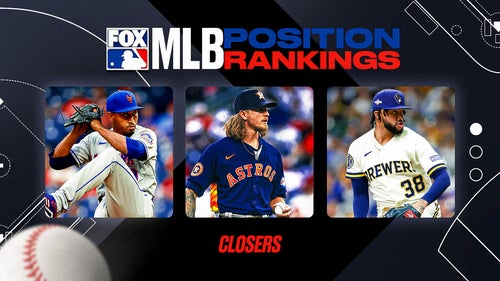
Dodgers' stars may need time to jell
WARNING: The theory that I am about to advance cannot be quantified. But in the spirit of baseball bi-partisanship, I urge the statistically inclined to read to the end, then pause 10 seconds for reflection before bombarding me with any dismissive tweets.
The theory is this: The Los Angeles Dodgers have not yet jelled, and might not jell until next season, after their players have experienced a pennant race together and bonded over a full spring.
Yes, I’m talking about chemistry. Cohesiveness. Intangibles. All of those funky things that a computer cannot measure. All of those funky things that make the sport an enduring mystery, yet drive the statistically inclined to distraction.
I can’t fall too in love with my theory, not when the Dodgers can disprove it at any moment, starting this weekend when they visit the San Francisco Giants in a pivotal NL West showdown (Saturday, MLB on FOX, 4:10 p.m. ET).
But seriously, what other explanation is there for the Greatest Lineup Ever Slapped Together producing only 20 runs in the Dodgers’ seven-game homestand against the Arizona Diamondbacks and San Diego Padres?
How else can one account for the Dodgers being only 5-7 since acquiring first baseman Adrian Gonzalez and right-hander Josh Beckett from the Boston Red Sox — after acquiring shortstop Hanley Ramirez from the Miami Marlins and left fielder Shane Victorino from the Philadelphia Phillies?
Those luminaries aren’t the Dodgers’ only additions since the final week of July; the club also added infielder Nick Punto and injured outfielder Carl Crawford from the Red Sox and right-hander Joe Blanton from the Phillies, left-handed reliever Randy Choate from the Marlins and right-handed reliever Brandon League from the Seattle Mariners. The team’s latest newcomer, right-handed reliever Paco Rodriguez, most recently was with the University of Florida, and is the first 2012 draft pick to reach the majors.
We’re talking about huge turnover, perhaps unprecedented turnover for a contender. And club officials privately acknowledge that the team’s sluggish, inconsistent play after the massive overhaul might be attributable to the players’ unfamiliarity with one another.
Those officials believe other factors also are in play. Hitters facing increased expectations, trying to do too much, taking ill-advised swings at pitches that they cannot handle. Pitchers such as right-hander Chad Billingsley, left-hander Ted Lilly and righty reliever Kenley Jansen being physically unable to contribute — though Lilly and Jansen could return, both in the bullpen, later this month.
Teams never struggle for just one reason. The Dodgers’ new lineup is so formidable on paper, no one should be surprised if the club goes on a tear the rest of the way. Yet, at the time of year when a team’s espirit d’corps matters most, the Dodgers are still learning about each other. The newcomers are still getting accustomed to manager Don Mattingly and his staff, not to mention a new city and in some cases, a new league.
It’s the same phenomenon that free agents experience when they change teams, only multiplied. Ask Albert Pujols, who didn’t immediately produce with the Los Angeles Angels. Ask Adam Dunn, who needed a full season to adjust with the Chicago White Sox. Ask Crawford, who might never have grown comfortable with the Red Sox, and will stand a better chance next season with the Dodgers when he recovers from Tommy John surgery.
One executive likened the Dodgers’ predicament to that of Team USA in the World Baseball Classic; Team USA is a hastily assembled All-Star squad, while the rosters of countries such as Japan and Korea often include many players who previously competed together on the international stage.
The New York Yankees, of course, are an exception, frequently pulling players from other clubs yet contending season after season. The influence of shortstop Derek Jeter is one reason why the Yankees make it work — he sets a powerful example, and his teammates fall into line. But even the Yankees’ world would be rocked if they flipped nearly one-third of their roster at midseason. The same goes for the Texas Rangers, another team with a strong clubhouse culture.
Every team experiences turnover, but every team also draws from its shared experiences. Thirteen current Giants were part of the club that won the 2010 World Series. There is value in that. A number of contenders, most notably the Tampa Bay Rays, are built around homegrown players who share a history dating back to the minors. There is value in that, too.
How much value? No one can say. But some Dodgers officials believe that the team will be better next season, and not simply because of the return of Crawford, who likely will replace Victorino. None of the Dodgers’ major offensive additions is older than 31. And next spring, all of the new players will be together under Mattingly, whom the Dodgers are counting on to massage all the egos and form a cohesive unit.
Which isn’t to say the Dodgers won’t rally for a playoff berth this season; any team with Gonzalez, Ramirez, Matt Kemp and Andre Ethier in the middle of its order is capable of terrific things. All I’m saying is that if the Dodgers fall short, it will illustrate the difficulty of building a contender on the fly.
That’s my theory, and I can’t quantify it, can’t prove it. All I know is, the games aren’t played on paper or on a computer. They’re played by individuals, and the relationships between those individuals can influence the team’s overall dynamic and quite possibly its performance.
OK, time for your 10-second pause. Think about what I’m saying. And tell me, with the absolute certainty that the statistically inclined crave, that I am wrong.










